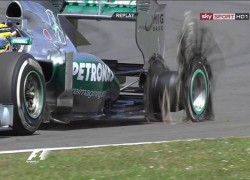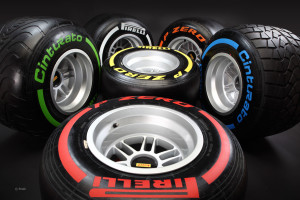
Pirelli has issued the following statement tonight, regarding what happened at Silverstone – and what they plan to do next.
After exhaustive analysis of the tyres used at Silverstone, Pirelli has concluded that the causes of the failures were principally down to a combination of the following factors:
1) Rear tyres that were mounted the wrong way round: in other words, the right hand tyre being placed where the left hand one should be and vice versa, on the cars that suffered failures. The tyres supplied this year have an asymmetric structure, which means that they are not designed to be interchangeable. The sidewalls are designed in such a way to deal with specific loads on the internal and external sides of the tyre. So swapping the tyres round has an effect on how they work in certain conditions. In particular, the external part is designed to cope with the very high loads that are generated while cornering at a circuit as demanding as Silverstone, with its rapid left-hand bends and some kerbs that are particularly aggressive.
2) The use of tyre pressures that were excessively low or in any case lower than those indicated by Pirelli. Under-inflating the tyres means that the tyre is subjected to more stressful working conditions.
3) The use of extreme camber angles.
4) Kerbing that was particularly aggressive on fast corners, such as that on turn four at Silverstone, which was the scene of most of the failures. Consequently it was the left-rear tyres that were affected.
The only problems that had come to light before Silverstone were to do with delamination, which was a completely different phenomenon. To stop these delaminations Pirelli found a solution by suggesting that the teams use the tyres that were tried out in Canada from Silverstone onwards. When this proposal was not accepted, Pirelli found another solution through laboratory testing, with a different bonding process to attach the tread to the carcass. So the problem of delamination has nothing at all to do with what was seen in Great Britain.
Following the conclusions of this analysis, Pirelli would like to underline that:
1) Mounting the tyres the wrong way round is a practice that was nonetheless underestimated by everybody: above all Pirelli, which did not forbid this.
2) In the same way, under-inflation of the tyres and extreme camber settings, over which Pirelli has no control, are choices that can be dangerous under certain circumstances. Because of this, Pirelli has asked the FIA for these parameters will be a topic of accurate and future examinations. Pirelli has also asked for compliance with these rules to be checked by a dedicated delegate.
3) Pirelli would also like to underline that the 2013 tyre range does not compromise driver safety in any way if used in the correct manner, and that it meets all the safety standards requested by the FIA.
 The logical conclusion is that it is essential for tyres with the performance and technical sophistication of the 2013 range to be regulated and carefully controlled by Pirelli itself. In order to ensure the optimal functioning of the tyres, the Italian firm would need real-time data from the teams regarding fundamental parameters such as pressure, temperature and camber angles. While waiting for new regulations that would permit Pirelli access to this data, vital for the development and management of these state-of-the-art tyres, the following measures are proposed for the forthcoming grands prix, in agreement with the FIA, FOM, the teams and the drivers:
The logical conclusion is that it is essential for tyres with the performance and technical sophistication of the 2013 range to be regulated and carefully controlled by Pirelli itself. In order to ensure the optimal functioning of the tyres, the Italian firm would need real-time data from the teams regarding fundamental parameters such as pressure, temperature and camber angles. While waiting for new regulations that would permit Pirelli access to this data, vital for the development and management of these state-of-the-art tyres, the following measures are proposed for the forthcoming grands prix, in agreement with the FIA, FOM, the teams and the drivers:
1) The use of the evolution of the current tyre that was tested in Canada (and proved to be completely reliable) for the German Grand Prix this weekend. This represents the best match for the technical characteristics of the Nurburgring circuit. In particular, the rear tyres that will be used at the German Grand Prix, which takes place on July 7, have a Kevlar construction that replaces the current steel structure and the re-introduction of the 2012 belt, to ensure maximum stability and roadholding. Given that these tyres are asymmetric as well, it will be strictly forbidden to swap them round. The front tyres, by contrast, will remain unaltered.
2) From the Hungarian Grand Prix onwards, the introduction of a new range of tyres. The new tyres will have a symmetrical structure, designed to guarantee maximum safety even without access to tyre data – which however is essential for the optimal function of the more sophisticated 2013 tyres. The tyres that will be used for the Hungarian Grand Prix onwards will combine the characteristics of the 2012 tyres with the performance of the 2013 compounds. Essentially, the new tyres will have a structure, construction and belt identical to that of 2012, which ensured maximum performance and safety. The compounds will be the same as those used throughout 2013, which guaranteed faster lap times and a wider working range. This new specification, as agreed with the FIA, will be tested on-track together with the teams and their 2013 cars at Silverstone from 17-19 July in a session with the race drivers during the young driver test. These tests will contribute to the definitive development of the new range of tyres, giving teams the opportunity to carry out the appropriate set-up work on their cars.
What do you think about Pirelli’s statement? Is it reasonable to be shifting the blame to the teams? What are your thoughts? Leave us a comment below.



One Response to “Pirelli: full statement regarding the Silverstone debacle”
Trackbacks/Pingbacks
[…] This follows a request by Pirelli to the FIA, to limit how F1 teams exploit the rubber because according to Pirelli this was a major contributing factor to the blow-outs suffered at the British Grand Prix. Earlier this week, Pirelli openly blamed teams in a statement for the failures at Silverstone. […]